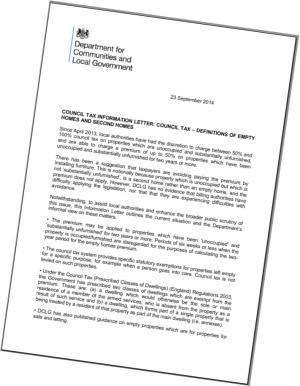
Find more posts
Government issues guidance on definitions of empty homes and second homes
Latest
September 25, 2014



The Department of Communities and Local Government has issued a letter to clarify the definitions of empty homes and second homes. The letter, signed by Hülya Mustafa, a Deputy Director for Council Tax, seems to have been prompted by concerns about avoidance, whereby otherwise empty homes have furniture put in them specifically to avoid the Empty Homes Premium.
Incidence of avoidance
The letter is keen to point out that there is little evidence for people introducing furniture into properties to avoid paying the Empty Homes Premium. Anecdotal evidence from around the country generally seems to support that view but members with different experience or concrete data to report are encouraged to add a Comment to this story accordingly. You'll need to log in to do so.
Who decides
As regards the meanings of "unoccupied" and "substantially unfurnished" the letter emphasises the central role of local authorities' views along with the views of any court that might decide on the issue, and indicates that the courts would treat the matter on its own merits, as "a matter of fact", rather than deferring to the government's guidance.
In adopting this position, DCLG is not being evasive: this can be considered the normal and appropriate government stance in circumstances where there is no statutory guidance or any powers to issue such guidance.Were it to do more, it could rightly be criticised for over-stepping the limits of executive authority.
Criteria
As far as it goes, the specific government advice on determining whether a dwelling is "substantiallly unfurnished" and/or unoccupied runs as follows:
A property which is substantially unfurnished is unlikely to be occupied or be capable of occupation. A property which is capable of occupation can reasonably be expected to contain some, if not all, items from both of the following categories: furniture such as bed, chairs, table, wardrobe or sofa, and white goods such as fridge, freezer or cooker.
Where a property is said to be occupied it will be reasonable for the local authority to cross-check with the electoral roll , or ask for evidence, such as utility bills showing usage of services, driving licence as proof of address, or receipts or other proof of moving costs.
Reference is made to other guidance but the letter does not contain hyperlinks to the documents mentioned such as the advisory notes related to properties for letting or for sale (accessible via our library here).
Penalties
As regards tax evasion rather than tax avoidance, the letter points out that there are civil penalties attached to people deliberately supplying false information. Under the council tax legislation there is a fixed civil penalty of £50. It also notes that the Theft Act 1968 applies to council tax though it does not elaborate as no doubt the position will be clear to those in Council Tax departments who are presumably the target readership. The following notes from LB of Merton spell it out:
The Theft Act 1968 also applies to Council Tax where a person presents information which they know to be false with a view to obtaining a financial benefit to which they are not entitled. You could be subject to prosecution for obtaining a pecuniary advantage by deception.
EHN emerging policy
The letter expresses the current position as seen through government eyes. But what would be the preferred position? EHN policy, as elaborated to date though not formally adopted, would be as follows:
- drop the distinction between second homes and empty homes by removing the criterion around the presence of furniture
- therefore distinguish only between homes that are occupied as someone's main residence and homes that are not (the latter could be "second homes" or "empty homes")
- apply Empty Homes Premium after 1 year not 2 and at a rate of up to 100%
- apply EHP to all homes that are not primary residences - thus "second homes" too.
